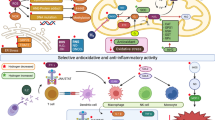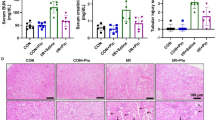Abstract
Remodeling by its very nature implied synthesis and degradation of extracellular matrix (ECM) proteins. Although oxidative stress, matrix metalloproteinase (MMP) and tissue inhibitor of metalloproteinase (TIMP) have been implicated in vascular remodeling, the differential role of MMPs versus TIMPs and oxidative stress in vascular remodeling was unclear. TIMP-3 induced vascular cell apoptosis, therefore, we hypothesized that during vascular injury TIMP-3, MMP-9 and -12 (elastin-degrading MMP) were increased, whereas MMP-2 (constitutive MMP) and TIMP-4 (cardioprotective TIMP) decreased. Because of the potent anti-oxidant, vasorelaxing, anti-hypertensive agent, hydrogen sulfide (H2S) was used to mitigate the vascular remodeling due to the differential expression of MMP and TIMP. Carotid artery injury was created by inserting a PE-10 catheter and rotating several times before pulling out. The insertion hole was sealed. Mice were grouped: wild type (WT), wild-type damaged artery (WTD), WT + NaHS (sodium hydrogen sulfide, precursor of H2S) treatment (30 µmol/L in drinking water/6 weeks) and WTD + NaHS treatment. Carotid arteries were analyzed for oxidative stress and remodeling, by measuring super oxide dismutase-1 (SOD1), p47 (NADPH oxidase subunit), nitrotyrosine, MMPs and TIMPs by in situ immunolabeling and by Western blot analyses. The results suggested robust increase in p47, nitrotyrosine, MMP-9, MMP-12, TIMP-3 and decrease in SOD1 and MMP-2 levels in the injured arteries. The treatment with H2S ameliorated these effects. We concluded that p47, TIMP-3, MMP-9 and -12 were increased where as SOD-1, MMP-2 and TIMP-4 were decreased in the injured arteries. The treatment with H2S mitigated the vascular remodeling by normalizing the levels of redox stress, MMPs and TIMPs.






Similar content being viewed by others
Abbreviations
- AVF:
-
Aorta–venacava fistula.
- BW:
-
Body weight
- H2S:
-
Hydrogen sulfide
- MMP:
-
Matrix metalloproteinase
- NADPH:
-
Nicotinamide adenosine dihydrogenphosphate
- NaHS:
-
Sodium hydrogen sulfide
- p47:
-
Protein of 47 kDa
- ROS:
-
Reactive oxygen species
- RNS:
-
Reactive nitrogen species
- RTS:
-
Reactive thiol species
- SOD:
-
Superoxide dismutase
- STS:
-
Sodium thiosulfide
- TIMP:
-
Tissue inhibitor of metalloproteinase
- WT:
-
Wild type
- WTD:
-
Wild-type damaged artery
References
Adhikari S, Bhatia M (2008) H2S-induced pancreatic acinar cell apoptosis is mediated via JNK and p38 MAP kinase. J Cell Mol Med 12:1374–1383
Al-Chalabi A, Leigh PN (2000) Recent advances in amyotrophic lateral sclerosis. Curr Opin Neurol 13:397–405
Ali MY, Ping CY, Mok YY, Ling L, Whiteman M, Bhatia M, Moore PK (2006) Regulation of vascular nitric oxide in vitro and in vivo; a new role for endogenous hydrogen sulphide? Br J Pharmacol 149:625–634
Baker AH, Zaltsman AB, George SJ, Newby AC (1998) Divergent effects of tissue inhibitor of metalloproteinase-1, -2, or -3 overexpression on rat vascular smooth muscle cell invasion, proliferation, and death in vitro. TIMP-3 promotes apoptosis. J Clin Invest 101:1478–1487
Baskar R, Li L, Moore PK (2007) Hydrogen sulfide-induces DNA damage and changes in apoptotic gene expression in human lung fibroblast cells. FASEB J 21:247–255
Cao Y, Adhikari S, Ang AD, Moore PK, Bhatia M (2006) Mechanism of induction of pancreatic acinar cell apoptosis by hydrogen sulfide. Am J Physiol Cell Physiol 291:C503–C510
Collin M, Anuar FB, Murch O, Bhatia M, Moore PK, Thiemermann C (2005) Inhibition of endogenous hydrogen sulfide formation reduces the organ injury caused by endotoxemia. Br J Pharmacol 146:498–505
Conwit RA (2006) Preventing familial ALS: a clinical trial may be feasible but is an efficacy trial warranted? J Neurol Sci 251:1–2
Elrod JW, Calvert JW, Morrison J, Doeller JE, Kraus DW, Tao L, Jiao X, Scalia R, Kiss L, Szabo C, Kimura H, Chow CW, Lefer DJ (2007) Hydrogen sulfide attenuates myocardial ischemia-reperfusion injury by preservation of mitochondrial function. Proc Natl Acad Sci USA 104:15560–15565
Hayden MR, Tyagi SC, Kolb L, Sowers JR, Khanna R (2005) Vascular ossification-calcification in metabolic syndrome, type 2 diabetes mellitus, chronic kidney disease, and calciphylaxis-calcific uremic arteriolopathy: the emerging role of sodium thiosulfate. Cardiovasc Diabetol 4:4
Henderson BC, Tyagi SC (2006) Oxidative mechanism and homeostasis of proteinase/antiproteinase in congestive heart failure. J Mol Cell Cardiol 41:959–962
Herzlich BC, Lichstein E, Schulhoff N, Weinstock M, Pagala M, Ravindran K, Namba T, Nieto FJ, Stabler SP, Allen RH, Malinow MR (1996) Relationship among homocyst(e)ine, vitamin B-12 and cardiac disease in the elderly: association between vitamin B-12 deficiency and decreased left ventricular ejection fraction. J Nutr 126:1249S–1253S
Holven KB, Halvorsen B, Schulz H, Aukrust P, Ose L, Nenseter MS (2003) Expression of matrix metalloproteinase-9 in mononuclear cells of hyperhomocysteinaemic subjects. Eur J Clin Invest 33:555–560
Hu LF, Wong PT, Moore PK, Bian JS (2007) Hydrogen sulfide attenuates lipopolysaccharide-induced inflammation by inhibition of p38 mitogen-activated protein kinase in microglia. J Neurochem 100:1121–1128
Kartha GK, Moshal KS, Sen U, Joshua IG, Tyagi N, Steed MM, Tyagi SC (2008) Renal mitochondrial damage and protein modification in type-2 diabetes. Acta Diabetol 45:75–81
Koenitzer JR, Isbell TS, Patel HD, Benavides GA, Dickinson DA, Patel RP, Darley-Usmar VM, Lancaster JR Jr, Doeller JE, Kraus DW (2007) Hydrogen sulfide mediates vasoactivity in an O2-dependent manner. Am J Physiol Heart Circ Physiol 292:H1953–H1960
Li L, Bhatia M, Zhu YZ, Zhu YC, Ramnath RD, Wang ZJ, Anuar FB, Whiteman M, Salto-Tellez M, Moore PK (2005) Hydrogen sulfide is a novel mediator of lipopolysaccharide-induced inflammation in the mouse. FASEB J 19:1196–1198
Liu H, Bai XB, Shi S, Cao YX (2009) Hydrogen sulfide protects from intestinal ischaemia–reperfusion injury in rats. J Pharm Pharmacol 61:207–212
Lominadze D, Roberts AM, Tyagi N, Moshal KS, Tyagi SC (2006) Homocysteine causes cerebrovascular leakage in mice. Am J Physiol Heart Circ Physiol 290:H1206–H1213
Luo J (2005) The role of matrix metalloproteinases in the morphogenesis of the cerebellar cortex. Cerebellum 4:239–245
Malemud CJ (2006) Matrix metalloproteinases (MMPs) in health and disease: an overview. Front Biosci 11:1696–1701
Meissner M, Gille J, Kaufmann R (2006) Calciphylaxis: no therapeutic concepts for a poorly understood syndrome? J Dtsch Dermatol Ges 4:1037–1044
Moshal KS, Tyagi N, Moss V, Henderson B, Steed M, Ovechkin A, Aru GM, Tyagi SC (2005) Early induction of matrix metalloproteinase-9 transduces signaling in human heart end stage failure. J Cell Mol Med 9:704–713
Moshal KS, Sen U, Tyagi N, Henderson B, Steed M, Ovechkin AV, Tyagi SC (2006) Regulation of homocysteine-induced MMP-9 by ERK1/2 pathway. Am J Physiol Cell Physiol 290:C883–C891
Moshal KS, Metreveli N, Frank I, Tyagi SC (2008) Mitochondrial MMP activation, dysfunction and arrhythmogenesis in hyperhomocysteinemia. Curr Vasc Pharmacol 6:84–92
Raymond J, Lebel V, Ogoudikpe C, Metcalfe A, Chagnon M, Robledo O (2004) Recanalization of arterial thrombus, and inhibition with beta-radiation in a new murine carotid occlusion model: MRNA expression of angiopoietins, metalloproteinases, and their inhibitors. J Vasc Surg 40:1190–1198
Rose P, Moore PK, Ming SH, Nam OC, Armstrong JS, Whiteman M (2005) Hydrogen sulfide protects colon cancer cells from chemopreventative agent beta-phenylethyl isothiocyanate induced apoptosis. World J Gastroenterol 11:3990–3997
Sen U, Herrmann M, Herrmann W, Tyagi SC (2007a) Synergism between AT1 receptor and hyperhomocysteinemia during vascular remodeling. Clin Chem Lab Med 45:1771–1776
Sen U, Tyagi N, Kumar M, Moshal KS, Rodriguez WE, Tyagi SC (2007b) Cystathionine-beta-synthase gene transfer and 3-deazaadenosine ameliorate inflammatory response in endothelial cells. Am J Physiol 293:C1779–C1787
Sen U, Vacek TP, Hughes WM, Kumar M, Moshal KS, Tyagi N, Metreveli N, Hayden MR, Tyagi SC (2008) Cardioprotective role of sodium thiosulfate on chronic heart failure by modulating endogenous H2S generation. Pharmacology 82:201–213
Sen U, Basu P, Abe OA, Givvimani S, Tyagi N, Metreveli N, Shah KS, Passmore JC, Tyagi SC (2009) Hydrogen sulfide ameliorates hyperhomocysteinemia-associated chronic renal failure. Am J Physiol Renal Physiol 297:F410–F419
Shastry S, Moning L, Tyagi N, Steed M, Tyagi SC (2005) GABA receptors and nitric oxide ameliorate constrictive collagen remodeling in hyperhomocysteinemia. J Cell Physiol 205:422–427
Shastry S, Tyagi N, Moshal KS, Lominadze D, Hayden MR, Tyagi SC (2006) GABA receptors ameliorate Hcy-mediated integrin shedding and constrictive collagen remodeling in microvascular endothelial cells. Cell Biochem Biophys 45:157–165
Sivarajah A, Collino M, Yasin M, Benetti E, Gallicchio M, Mazzon E, Cuzzocrea S, Fantozzi R, Thiemermann C (2009) Anti-apoptotic and anti-inflammatory effects of hydrogen sulfide in a rat model of regional myocardial I/R. Shock 31:267–274
Tisherman SA, Drabek T (2008) Hydrogen sulfide: metabolic mediator or toxic gas? Pediatr Crit Care Med 9:129–130
Tyagi N, Sedoris KC, Steed M, Ovechkin AV, Moshal KS, Tyagi SC (2005a) Mechanisms of homocysteine-induced oxidative stress. Am J Physiol Heart Circ Physiol 289:H2649–H2656
Tyagi SC, Lominadze D, Roberts AM (2005b) Homocysteine in microvascular endothelial cell barrier permeability. Cell Biochem Biophys 43:37–44
Wagner F, Asfar P, Calzia E, Radermacher P, Szabo C (2009) Bench-to-bedside review: hydrogen sulfide–the third gaseous transmitter: applications for critical care. Crit Care 13:213
Wald DS, Law M, Morris JK (2002) Homocysteine and cardiovascular disease: evidence on causality from a meta-analysis. Br Med J 325:1202
Webb GD, Lim LH, Oh VM, Yeo SB, Cheong YP, Ali MY, El OR, Lee CN, Wong PS, Caleb MG, Salto-Tellez M, Bhatia M, Chan ES, Taylor EA, Moore PK (2008) Contractile and vasorelaxant effects of hydrogen sulfide and its biosynthesis in the human internal mammary artery. J Pharmacol Exp Ther 324:876–882
Whiteman M, Armstrong JS, Chu SH, Jia-Ling S, Wong BS, Cheung NS, Halliwell B, Moore PK (2004) The novel neuromodulator hydrogen sulfide: an endogenous peroxynitrite ‘scavenger’? J Neurochem 90:765–768
Whiteman M, Li L, Kostetski I, Chu SH, Siau JL, Bhatia M, Moore PK (2006) Evidence for the formation of a novel nitrosothiol from the gaseous mediators nitric oxide and hydrogen sulphide. Biochem Biophys Res Commun 343:303–310
Yang G, Yang W, Wu L, Wang R (2007) H2S, endoplasmic reticulum stress, and apoptosis of insulin-secreting beta cells. J Biol Chem 282:16567–16576
Zhang H, Zhi L, Moore PK, Bhatia M (2006) Role of hydrogen sulfide in cecal ligation and puncture-induced sepsis in the mouse. Am J Physiol Lung Cell Mol Physiol 290:L1193–L1201
Zhang H, Zhi L, Moochhala S, Moore PK, Bhatia M (2007a) Hydrogen sulfide acts as an inflammatory mediator in cecal ligation and puncture-induced sepsis in mice by upregulating the production of cytokines and chemokines via NF-κB. Am J Physiol Lung Cell Mol Physiol 292:L960–L971
Zhang H, Zhi L, Moochhala SM, Moore PK, Bhatia M (2007b) Endogenous hydrogen sulfide regulates leukocyte trafficking in cecal ligation and puncture-induced sepsis. J Leukoc Biol 82:894–905
Zhang Z, Huang H, Liu P, Tang C, Wang J (2007c) Hydrogen sulfide contributes to cardioprotection during ischemia-reperfusion injury by opening K ATP channels. Can J Physiol Pharmacol 85:1248–1253
Zhang H, Moochhala SM, Bhatia M (2008) Endogenous hydrogen sulfide regulates inflammatory response by activating the ERK pathway in polymicrobial sepsis. J Immunol 181:4320–4331
Acknowledgments
A part of this study was supported by NIH Grants; HL-71010; HL-88012; and NS-51568.
Author information
Authors and Affiliations
Corresponding author
Rights and permissions
About this article
Cite this article
Vacek, T.P., Gillespie, W., Tyagi, N. et al. Hydrogen sulfide protects against vascular remodeling from endothelial damage. Amino Acids 39, 1161–1169 (2010). https://doi.org/10.1007/s00726-010-0550-2
Received:
Accepted:
Published:
Issue Date:
DOI: https://doi.org/10.1007/s00726-010-0550-2




